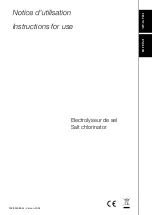
Page 26
replacing the valve, be sure that the pump is off.
Install the valve so that the discharge is directed
away from any area that may be damaged by
water.
6.
Be sure all combustion air and ventilation
openings are not blocked. Check for spider webs
and other debris inside the heater, in the vents on
all sides of the heater jacket and in the exhaust
outlet– especially after a long period of nonuse.
8.3.2. Professional Inspection
Inspections performed at least once a year by a
qualified technician are required to maintain your
heater's safe and efficient operation. The following
basic safety checks must be performed.
1.
Inspect the venting system for blockage, leakage,
and corrosion.
2.
Inspect burners and verify that they are clean.
Clean with a wire brush if necessary to remove
debris.
3.
Check for spider webs and other debris in the
pilot and main burner orifices - especially at
spring start-up.
4.
Check for loose or broken wires and terminal
connections.
5.
Make sure that the pressure switch operates
properly by shutting the filter pump off and on a
few times. The burner should go off immediately
after the pump stops. An ignition sequence
should start shortly after the pump is turned back
on.
6.
Make a visual check of the main burner flame.
The flame can be seen in a mirror arrangement
held beneath the burners. The flame should be
a. Blue in color.
b. 1 to 4 inches (25mm to 102mm) above burner
surface (see Figure 22).
7.
Inspect the gas and electronic controls, including
the following:
a. High temperature limit switch
b. Water pressure switch
c. Automatic gas valve
d. Fusible Link
e. Temperature control
f. Control circuit fuse
8.
Perform a temperature rise test in accordance
with Section 7.6.
9.
If the heater is equipped with a pressure relief
valve, check for corrosion in and around the
valve. With the filter pump on, lift the release
lever on the top of the valve to make sure that
water runs freely through it. If corrosion is found,
replace the pressure relief valve. When replacing
the valve, be sure that the pump is off. Install the
valve so that the discharge is directed away from
any area that may be damaged by water.
10.
Inspect the external surfaces of the heat ex-
changer tubes for black carbon soot buildup by
placing a mirror between and under the burners
when the heater is firing. Remove any soot that
has collected on the tubes, and correct the cause.
NOTE:
After installation and first start-up,
check the heat exchanger for black carbon soot
buildup after the following periods of operation:
24 hours, 7 days, 30 days, 90 days, and once
every 6 months thereafter.
11.
Conduct a normal operating cycle and observe
that the sequence proceeds as intended.
CAUTION
For your safety, when starting the heater, keep
your head and face away from the burner area
opening to prevent any risk of personal injury.
NOTE
: Keep this manual in a safe place for
future reference by you and your professional
technician when inspecting and servicing the
heater.
Figure 22. Main Burner Flame.













































